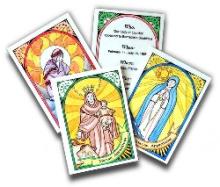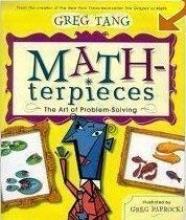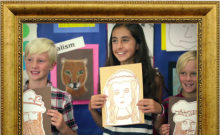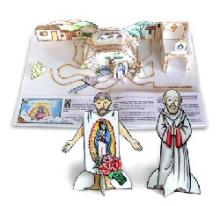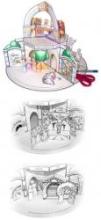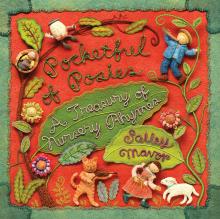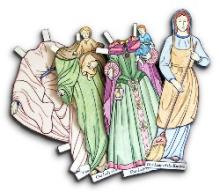Art
Marian Apparition Trading Cards from Illuminated Ink
Marian Grotto Kit from Illuminated Ink
Math-terpieces
Perusing through the Math titles in Picture Books at the library last week I found lots of books. Alas, most of them were, well, boring. Uninteresting. I brought a handful home to investigate and of those I found a few nice volumes including this one!
I love almost anything that is integrated with Art. (Well, almost anything.) My younger homeschool students are all artistically oriented and if I integrate a subject with Art I get smiles. I am doing just that with History this semester with happy results: I provide a workpage with a theme and examples to be created and colored artistically for each chapter of Seton's The Catholic Faith Comes to the Americas.
This is a simple Math book for young ones: from each famous painting the clever illustrator took one element and displayed it on the facing pages in different sizes, colors, and groups. By grouping the elements in different ways, young Math students have a peek into the world of addition, multiplication and beyond. On the side, they will enjoy a quick tour of the art world in chronological order and some cute rhymed lines as well!
Meet the Masters
Years ago, a friend who teaches university-level art classes, told me that the best way for me to teach my children art was to combine how-to instruction with art appreciation. She suggested learning about the life of a particular artist by reading biographies and then learn how to imitate his or her technique. This made perfect sense to me, but I did not feel knowledgeable enough in the subject matter to put together my own curriculum and I did not know of any such art program that could be used in the home.
Enter Meet the Masters. This program integrates how-to instruction with art appreciation.
To review Meet the Masters, I invited two other families to join me and my children in using the program, forming a co-op of sorts. My desire was to get a feel of the program myself, as well as see how other families responded to the instruction. I am happy to report that our little art co-op was very successful.
In the first lesson the children learned about the life of Vincent Van Gogh, through the CD-ROM that comes with the program and the Internet. All of the children gathered around me and the computer, as I read from the script that comes with the program. It is good that Meet the Masters provides scripted instruction, as my personal knowledge of famous artists is admittedly limited. I learned about the life of Van Gogh alongside my children.
After reviewing Van Gogh's biography, we moved to the dining room table where we learned about his art technique and the children could mimic it. The program provides careful instructions on how to help the children with the lesson. It also provides a supply list and set-up instructions, so I was well prepared before our friends arrived.
I enhanced the program a little by searching out more of Van Gogh's artwork on the Internet and even saved one of his paintings to use as "wallpaper" on the children's computer (just left-click on the picture). That way every time the children booted up the computer, they were treated to a beautiful piece of art. I also picked up a children's biography at the library.
We met with our friends every other week until the program was finished. During that time we learned about Mary Cassatt, Piet Mondrian, Pablo Picasso, Claude Monet, and Winslow Homer. My children and the children of my friends (ages seven to twelve) all enjoyed the program and were even heard speaking about things such as texture, complementary colors, contrast, and the such throughout the weeks. On more than one occasion, my children recognized, and were excited to see, prints of the artists that we studied while visiting friends' homes or the doctor's office.
Though I do like this program very much, I am disappointed at the high price tag. It is expensive and parents must weigh the benefits with the cost carefully. However, the publisher does offer a generous discount if customers order more than one grade level at one time. A computer with a CD-ROM and Internet access is necessary to use Meet the Masters.
Note: This review is a bit out-dated. You can look at their current offerings here: http://meetthemasters.com/
Our Lady of Guadalupe Cut'n'Color Kit from Illuminated Ink
Passion Play Cut'n'Color Kit from Illuminated Ink
Pocketful of Posies
The entire book was stitched and photographed, and it is one delightful page after another! Enjoy the book's page at the author's website as it offers many inside views plus this series of posts that show a lot of interesting photos on the making of the book, posted by the author!
The nursery rhymes include many old favorites from Mother Goose as well as some less-familiar ones, but it's the illustrations that absolutely steal the show! (Click on the cover image to get an idea.) Author and illustrator Salley Mavor apparently spent a decade developing and honing her trademark fabric relief technique before attempting to illustrate her first book. Each page is crafted from wool felt and sewn and embroidered with multicolored thread, with characters' faces painted on wooden beads. Mavor likes to make furniture and roofs from driftwood bits, and incorporates other found items such as acorn caps and shells into the pictures. She says that each scene takes nearly a month to complete!
The book's primary audience is preschoolers through grade 1 or so, but older children and adults will love the incredible artistry and attention to detail.
Review updated 26 Mar 2024 by Suchi Myjak.

